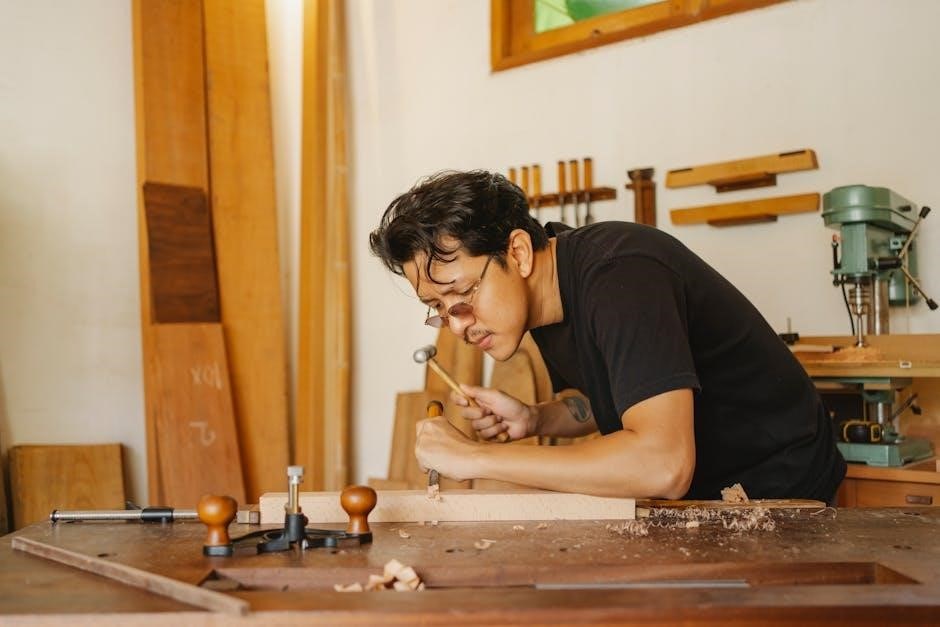various techniques and methods to identify authentic marks and signatures on pottery pieces made in the USA successfully always․
Importance of Pottery Marks in Identification

The importance of pottery marks in identification cannot be overstated, as they provide a wealth of information about the piece, including the artist, company, country of origin, and date of manufacture․
Using pottery marks is a crucial step in identifying and valuing a piece, and can help collectors and enthusiasts determine the authenticity and rarity of a piece․
By examining the mark, collectors can gain insight into the history and provenance of the piece, and make informed decisions about its value and significance․
Furthermore, pottery marks can also provide information about the materials and techniques used to create the piece, which can be useful in determining its condition and preservation․
Overall, the importance of pottery marks in identification is clear, and they remain a vital tool for anyone interested in collecting and appreciating pottery․
With the right knowledge and resources, collectors can use pottery marks to unlock the secrets of their pieces and gain a deeper understanding of their history and significance․
Popular Reference Books for American Pottery Marks
Several popular reference books can aid in identifying American pottery marks, including American Art Pottery: Identification and Values by Dick Sigafoose․
Another useful resource is Marks and Monograms on European and Oriental Pottery and Porcelain by William Chaffers, which provides a comprehensive guide to pottery marks․
These reference books are essential tools for collectors and enthusiasts, offering a wealth of information about American pottery marks and helping to identify and date pieces․
By consulting these resources, collectors can gain a deeper understanding of the history and significance of their pieces, and make informed decisions about their value and authenticity․
Additionally, these reference books often include detailed descriptions and images of pottery marks, making it easier to identify and verify the marks on a particular piece․
Overall, popular reference books are a valuable resource for anyone interested in identifying and collecting American pottery, and can help to build a more comprehensive understanding of this fascinating field․

Resources for Identifying American Pottery Marks
Utilize online directories and reference guides to identify American pottery marks successfully always using correct methods and techniques every time with available resources and information․
Online Directories for Pottery Marks
Online directories for pottery marks are essential tools for collectors and enthusiasts, providing access to a vast array of information on pottery marks, including images and descriptions of various marks․ These directories can be searched by mark, pattern, or manufacturer, making it easier to identify unknown pottery pieces․ Many online directories also include information on the history of pottery manufacturers, as well as tips for dating and authenticating pottery pieces․ Some popular online directories for pottery marks include the American Pottery Marks and Resource Directory, which features a comprehensive collection of pottery marks from US and Canadian manufacturers․ Additionally, online marketplaces and forums can also be useful resources for identifying pottery marks, as they often feature discussions and photos of various pottery pieces․ By utilizing these online directories, collectors and enthusiasts can gain a better understanding of pottery marks and improve their ability to identify and authenticate pottery pieces․ Overall, online directories are a valuable resource for anyone interested in pottery marks․
Identifying Vintage US Pottery and Ceramics
Identifying vintage US pottery and ceramics requires a combination of research and examination of the piece; The first step is to examine the piece for any visible marks or signatures, which can provide clues about the manufacturer and date of production․ Online resources, such as the American Pottery Marks and Resource Directory, can be used to research and identify the marks․ Additionally, collectors can look for characteristics such as the type of clay used, the glaze, and the shape and design of the piece․ Vintage US pottery and ceramics often have distinctive characteristics that can be used to identify the era and manufacturer․ For example, pottery from the mid-20th century may have a distinctive retro style, while earlier pieces may have a more modernist or art deco influence․ By carefully examining the piece and researching the marks and characteristics, collectors can gain a better understanding of the history and value of vintage US pottery and ceramics․ This knowledge can be used to authenticate and date the piece․

Identifying US Pottery by Clay Color and Manufacturing Process
Clay color and manufacturing process help identify US pottery origins and companies successfully always using online directories and reference guides for accurate identification purposes only․
Differences in US Ceramics and Manufacturing Process
The differences in US ceramics and manufacturing process are significant, with various techniques and materials used to create unique pieces․
The manufacturing process can vary greatly, from handcrafted to machine-made, and this can affect the overall quality and value of the piece․
Using online directories and reference guides, collectors can learn more about the different manufacturing processes and how they impact the final product․
By understanding the differences in US ceramics and manufacturing process, collectors can make more informed decisions when purchasing or identifying pieces․
The internet provides a wealth of information on this topic, with many resources available to help collectors learn more about US ceramics and the manufacturing process․
These resources can include articles, videos, and online forums, where collectors can connect with other enthusiasts and learn from their experiences․
Overall, the differences in US ceramics and manufacturing process are an important aspect of the usa pottery marks identification guide, and collectors should take the time to learn more about this topic․
Identifying Collectable and Vintage Pottery Dogs Made in the USA
Identifying collectable and vintage pottery dogs made in the USA requires a keen eye for detail and knowledge of the various manufacturers and artists who created these pieces․
Collectors can use online resources and reference guides to learn more about the different types of pottery dogs and their characteristics․
The internet provides a wealth of information on this topic, including articles, videos, and online forums where collectors can connect with other enthusiasts․
By studying the various marks, signatures, and styles used by different manufacturers and artists, collectors can develop the skills needed to identify collectable and vintage pottery dogs․
Many pottery dogs were produced by well-known manufacturers, such as Shawnee and Hull, and these pieces can be highly valuable to collectors․
Other artists, such as those associated with the Weller pottery company, also created highly collectable pottery dogs․
Overall, identifying collectable and vintage pottery dogs made in the USA is a fascinating hobby that requires patience, research, and attention to detail․

Ceramic Artists and Sculptors Working in the USA
Ceramic artists and sculptors in the USA create unique pieces, with
biographies
and images of their work available online for research and identification purposes always successfully;
Documenting Ceramic Artists and Their Marks
Documenting ceramic artists and their marks is a crucial step in the identification process, with many online resources and databases available to aid in research․ The use of
artist pages
and mark images can help to identify and authenticate pieces․ Each ceramic artist has a unique page that is continuously updated as new information and artwork become available․ This documentation process helps to build a comprehensive record of an artist’s work, including their marks, signatures, and styles․ By consulting these resources, collectors and enthusiasts can gain a deeper understanding of the ceramic artists and their marks, making it easier to identify and appreciate their work․ Additionally, the documentation of ceramic artists and their marks can also help to establish the value and provenance of a piece, making it an essential tool for anyone interested in collecting or researching ceramic art․
Collecting, Identifying, and Purchasing US Pottery and Jewelry
Collecting, identifying, and purchasing US pottery and jewelry requires a keen eye for detail and a thorough understanding of the market․ Many online resources and guides are available to help collectors navigate the process, including tips on how to identify authentic pieces and avoid counterfeit items․ When purchasing US pottery and jewelry, it is essential to research the seller and the item’s provenance to ensure authenticity․ Collectors can also learn about the different types of pottery and jewelry, such as copper, costume, gold, and silver, and how to care for and maintain their pieces․ By following these guidelines and staying informed, collectors can build a valuable and meaningful collection of US pottery and jewelry․ The process of collecting and identifying US pottery and jewelry can be rewarding and enjoyable, and with the right knowledge and resources, collectors can make informed purchasing decisions and appreciate their pieces for years to come․




About the author